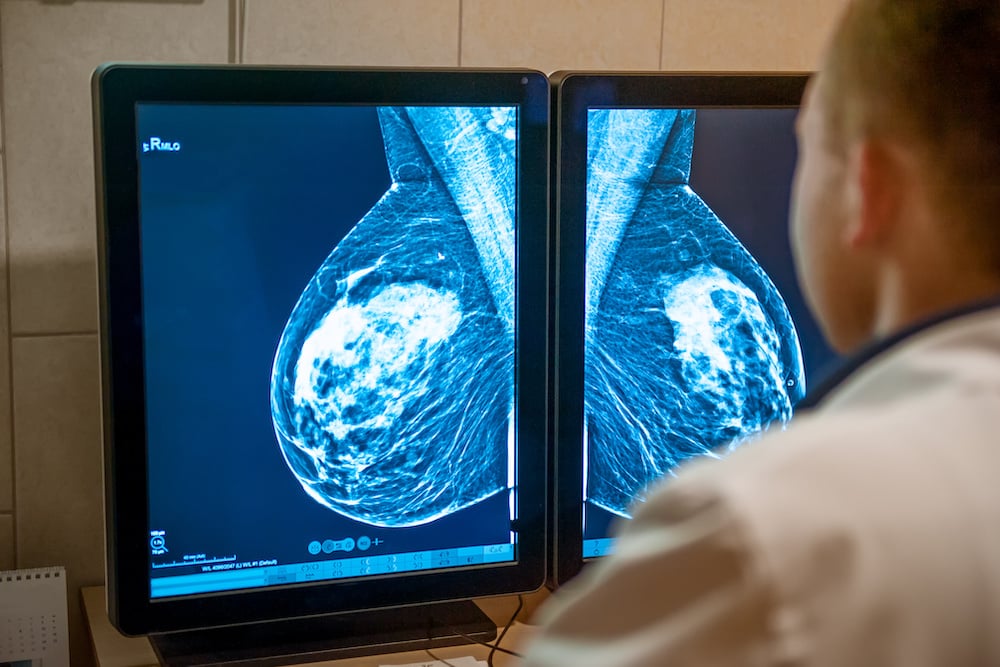Breast Cancer Screening: What is the BI-RADS Score and What Does it Mean for You?
6 min read

All women should be aware of breast cancer screening tests like mammograms and breast MRIs. The American Cancer Society recommends that all women who have an average risk for developing breast cancer start annual screening mammograms by age 45. A mammogram is an image of the breast used to detect any abnormal tissue growth that could be cancerous.
Learn more about breast cancer screening.
After getting a mammogram, breast ultrasound, or breast MRI, the radiologist who reviews the images will assign a BI-RADS score to help explain the results of the test. Keep reading to find out more about BI-RADS scores and what they mean for you.
Why Breast Cancer Screening is So Important
Breast cancer usually doesn’t cause symptoms until it’s grown large enough that it can be felt. And even then, sometimes it can be too deep in the breast tissue to be noticed. Thankfully there is an established screening process that can identify breast cancer at a much earlier stage in its growth. The five-year survival rate among women diagnosed with localized (early-stage) breast cancer is 99%.
Screening may need to start sooner than the American Cancer Society’s recommended age of 45 if you have a family history of breast cancer or other risk factors.
Take our quiz to learn more about breast cancer screening and other important facts!
Screening can be started sooner if your doctor feels it’s appropriate. There are some risks associated with starting breast cancer screening too early, so it is important to discuss the risks and benefits to determine if this is the right choice for you.
Learn about breast cancer risk factors.
Tests That Are a Part of Breast Cancer Screening
- Mammogram - The standard screening test is a mammogram. 3-D mammograms are known to be better, especially if you have dense breast tissue. Talk to the breast imaging center about whether 3-D is available.
- Breast MRI - Women who are at high risk may also have a breast MRI performed in addition to a mammogram. That’s because an MRI can identify some cancers that a mammogram cannot.
- Breast Ultrasound - This test is used in special situations, usually in addition to a mammogram, to look at changes in the breast such as lumps. It can also give a better look at dense breast tissue.
These tests are usually run by a technician and then read by a radiologist who specializes in reviewing breast images. In their evaluation of the images, they will give it a BI-RADS score.
Check out our blog: What to Expect at Your First Mammogram.
What is the BI-RADS Score?
The BI-RADS score stands for Breast Imaging Reporting and Data System. This scoring system is a universal strategy that allows doctors to provide patients with a ranking of their mammograms and other breast images to give them an idea of whether there is any cause for concern.
You may never hear about the BI-RADS score if your results are normal, meaning there is nothing unusual detected. However, if something is noticed that is of concern, your doctor may discuss this score with you.
Components of the BI-RADS Score
There are two main components to a BI-RADS score:
- Categories
- Breast density
The category of a BI-RADS score ranges from 0 to 6 and is as follows:
- 0: Incomplete imaging; additional testing or comparison to past mammograms is needed. A score of 0 could indicate that your radiologist saw a possible abnormality, but it wasn’t clear, so they will likely ask that you have additional testing done to confirm any findings. They may be able to simply compare the new mammogram with an older one to see if there have been any changes over time.
- 1: Negative for breast cancer. A normal test result where there were no new or abnormal findings.
- 2: Benign finding. This means that something was detected, but it was non-cancerous. There may be a growth, or other structure discovered that is benign or not cancerous, such as a change from a procedure that you had. The radiologist notes that there was a finding that is noncancerous so that this same finding is not mistaken as being cancerous on future tests.
- 3: Probably benign (non-cancerous) finding. In this circumstance, there was a finding that is unlikely to be cancerous, but it isn’t proven to be non-cancerous either. This means you’ll likely need a follow-up scan in 6 to 12 months until the finding is known to be stable. If there is change seen over time, then an early diagnosis is possible with frequent monitoring.
- 4: Suspicious abnormality, a biopsy may be recommended. A score of 4 does not definitely mean you have cancer, but it does warrant further testing, such as a biopsy. This category can include a wide range of concerns, so it is further broken down into categories.
- 4A includes findings with a low likelihood of being cancer, around a 2% to 10% chance.
- 4B describes a finding with a moderate likelihood of being cancer, about a 10% to 50% chance.
- 4C is more concerning, involving a high likelihood of about 50% to 95% that the growth is cancerous.
- 5: Category 5 is highly suggestive of cancer. These findings have a high about 95% chance of being cancerous. A biopsy would be highly recommended to confirm the findings.
- 6: This category describes a known malignancy that has already been confirmed with a biopsy. Sometimes this category is given when imaging scans are used to monitor cancer to see how well it is responding to treatment.
The other aspect of a BI-RADS score is breast density. This looks at how much fibrous and glandular tissue the breasts have compared with fatty tissue. The denser the breasts, the more difficult it is to see abnormal areas on a mammogram, and it slightly raises your risk of having breast cancer.
- Category A - almost all fatty breast tissue
- Category B - areas of dense glandular and fibrous tissue are in the breast
- Category C - More of the breast is made of dense glandular and fibrous tissue
- Category D - Extremely dense breast tissue
The more dense the breast tissue, the harder it is to see masses in the white areas of the mammogram images. This may lead to a discussion about other types of imaging as a part of screening.
Check out our blog: Five Things You Need to Know About Your Breasts and Self Exams
Importance of the BI-RADS Score
Understanding your BI-RADS score can give you and your doctor an idea of what types of next steps are required for you. If you end up with a 1, that’s actually a good thing! Then you can simply continue with routine check-ups. If your radiologist finds an abnormal growth, then it’s likely you’ll need additional imaging and/or a breast biopsy to identify whether the mass is cancer.
Breast cancer screening saves lives every year. Don’t skip it! And encourage your loved ones who are in the age range for screening to get screened.
After a Breast Cancer Diagnosis
If your test results come back positive for breast cancer you’re going to need a breast cancer specialist. They will guide you through the test results and will check to see if the cancer has moved outside of the breast. From there they will create a personalized treatment plan specifically for you. At Rocky Mountain Breast Specialists in Colorado, our team of cancer experts will work together to be sure you receive the best care possible. If you need to schedule a consultation, find a location near you.

